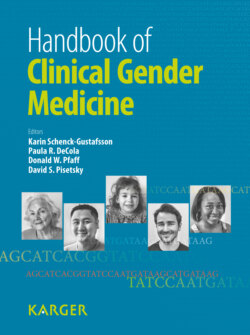Читать книгу Handbook of Clinical Gender Medicine - Группа авторов - Страница 64
Classification of Ambiguous Genitalia Chromosomal Disorders
ОглавлениеSex Reversal, Turner’s Syndrome, True Hemaphroditism, Mosaics, Mixed Gonadal Dysgenesis, and Pure Gonadal Dysgenesis. 46, XY sex reversal is a DSD resulting in individuals of the 46, XY genotype with female phenotypic characteristics or ambiguous genitalia and associated complete gonadal dysgenesis in ~1/20,000 births. The commitment of undifferentiated gonads to testes initiates the development into the male phenotype in normal 46, XY males. The Y chromosome has long been thought to carry the testis-determining factor (TDF). In the absence of the Y chromosome, such as in 46, XX normal females or 45, X Turner’s syndrome, the individuals are phenotypically female. The SRY is located at Yp11.3 and it was hoped that the discovery of SRY would lead to a rapid expansion of knowledge regarding early sex determination. However, SRY as the only TDF was shown to be a gross oversimplification. Many other genes active in sex differentiation have been confirmed, including genes coding for transcription factors such as SOX9 [Sry-type high-mobility group (HMG) box 9], DMTR1, GATA4, DAX1, SF1, WT1, LHX9, and DSS and signaling molecules antimullerian hormone (AMH), WNT4, FGF9, and DHH. Genes coding for the male phenotype have been found on X chromosomes (e.g. DSS) and autosomes 9, 10, and 17 (e.g. DMTR1).
Genetic mutations at the distal end of the short arm of chromosome 9 have been demonstrated in cases of 46, XY sex reversal. Namely, doublesex and MAB-3 related transcription factors 1 (DMRT1) and 2 (DMRT2) are mapped to band 9p24.3. DMRT1 appears to play a role in early sex differentiation while the role of DMRT2 is in somitogenesis. Genetic mutations at the distal 9p locus are typically de novo, resulting from deletions at 9p more often than point mutations. The shortest deletion at 9p still results in the loss of both DMRT1 and DMRT2, allowing for the possibility of both playing a role in early sex determination. This may also account for multiple phenotypic anomalies seen in association with XY sex reversal in certain individuals with 9p mutations. Individuals with 9p mutations and XY sex reversal have been observed to display abnormal facies, hypotonia, and cardiac and gastrointestinal defects, as well as mental and motor developmental delay.
